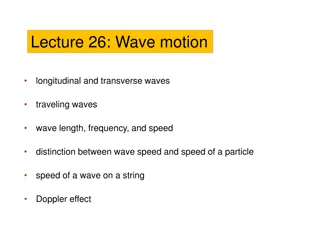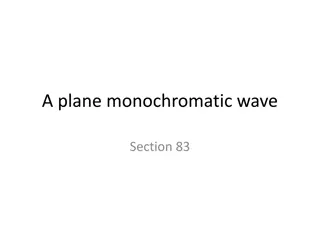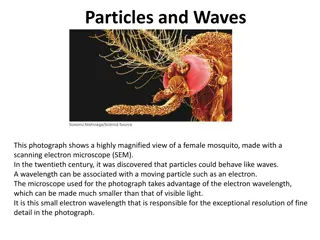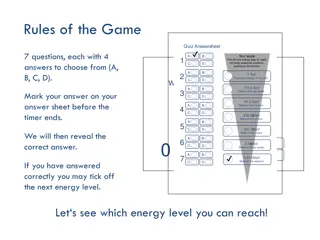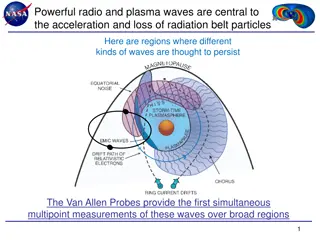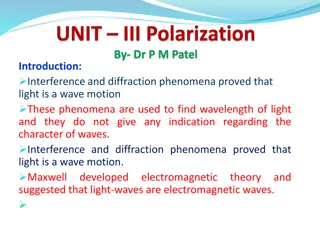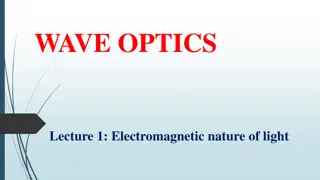Understanding the Dual Nature of Light: Wave and Particle Models
Light exhibits a dualistic nature, being describable both as a wave and a stream of particles known as photons. The wave model explains phenomena such as interference patterns, reflection, refraction, and diffraction, while the particle model clarifies how light can cause electrons to be emitted from a metal surface. The wavelength and frequency of electromagnetic radiation are key properties in understanding light's behavior and characteristics.
Uploaded on Sep 28, 2024 | 0 Views
Download Presentation

Please find below an Image/Link to download the presentation.
The content on the website is provided AS IS for your information and personal use only. It may not be sold, licensed, or shared on other websites without obtaining consent from the author. Download presentation by click this link. If you encounter any issues during the download, it is possible that the publisher has removed the file from their server.
E N D
Presentation Transcript
Physical Electronics Physical Electronics lecture-2 Wave Natural of Light Dr. Suha I. Al- Nassar
The two most common models describe light either as a wave or as a stream of particles. Thus Light has, a dualistic nature; it can be treated as a stream of particles (photons) or as a wave motion. When we deal with the optical effects of liquid crystals we sometimes use the first approach to treat light scattering, but normally the latter is used to treat the large number of interesting and often unique optical phenomena. 1-As a wave The light wave is a transverse electromagnetic wave motion. This means that it consists of two coupled, electric and magnetic, fields oscillating in a plane perpendicular to the beam direction .A small disturbance in an electric field creates a small magnetic field, Electromagnetic radiation : An Electromagnetic Wave is an alternating oscillations of the Electric (E) and Magnetic (B) fields . thus Electromagnetic radiation has both electric and magnetic properties. The wave-like property of electromagnetic radiation is due to the periodic oscillations of these components. The distance between wavecrests is called the wavelength ,it is denoted by We can assign a frequency and a wavelength to electromagnetic radiation, Because all electromagnetic radiation moves at the same speed (speed of light) wavelength and frequency are related
In 1801, the English scientist Thomas Young devised an experiment to test the nature of light. He passed a narrow beam of red light through two small openings. The light was focused onto a screen on the other side of the openings. He found that the light produced a striped pattern of light and dark bands on the screen. This striped pattern is an interference pattern. It also explains other behaviors of light, such as reflection, refraction, and diffraction. The wave model of light is still used to explain many of the basic properties of light and light s behavior. However, the wave model cannot explain all of light s behavior.
Electromagnetic radiation : Order of types of EM waves from long wavelength to short wavelength: (also order of small frequency to high frequency. Type Wavelength Range Radio wavelength > 1 cm Microwave 1 mm < wavelength < 1 cm Infrared 700 nm < wavelength < 1 mm Visible 400 nm < wavelength < 700 nm Ultraviolet 20 nm < wavelength < 400 nm X-rays 0.1 nm < wavelength < 20 nm Gamma rays wavelength < 0.1 nm
2-As a particle when light strikes a piece of metal, electrons may fly off the metal s surface. Scientists proposed a new model of light to explain the effects of light striking a metal plate they found that in dim blue light could cause electrons to fly off the metal plate. Scientists also found that very bright red light could not cause electrons to leave the plate. According to this model, the energy in light is contained in individual particles called photons . Photons of different colors of light have different amounts of energy. A photon of blue light carries more energy than a photon of red light. Therefore, blue light can cause electrons to fly off a metal plate, but red light cannot. Photons are considered particles, but they are not like particles of matter. Photons do not have mass. Instead, they contain only energy. Unlike the energy in a wave, the energy in a photon is located in a specific area. A beam of light is a stream of photons. The Energy carried by the photon is E = h - Where h = energy of photon = work function of metal = hc/ th E=the energy of escape electron from the surface =Vstop..e
DeBroglies Law De Broglie wave, also called matter wave , any aspect of the behavior or properties of a material object that varies in time or space in conformity with the mathematical equations that describe waves. The relation in which the de Broglie wave associated with a free particle of matter, and the electromagnetic wave in a vacuum associated with a photon, has a wavelength equal to Planck's constant divided by the particle's momentum and a frequency equal to the particle's energy divided by Planck's constant. Also known as de Broglie equation where h is Planck's constant. The equation can also be written as where is the reduced Planck's constant, is the wave vector, and is the angular frequency.
Schrodinger Equation .(11) called" Schr dinger s equation indepent time
Quantum Numbers Each different atomic orbital is characterized by a set of numbers called quantum numbers. These numbers determine the size, shape and orientation of the orbitals n, is the principal quantum number and is related to the size of the orbital. - It is a positive integer, 1, 2, 3, l, is the angular momentum quantum number and is related to the shape of the orbital. - It has an integer that runs from 0 to (n-1), where n is the corresponding principal quantum number. ml, is the magnetic quantum number and is related to the orientation of the orbital. - It is an integer that runs from -l to +l, where l is the corresponding angular momentum quantum number. ms, is the spin quantum number and is related to the spin of the orbital, it is always taking values (+1/2,-1/2) according to the orientation of electron.
Pauli Exclusion Principle No two electrons in an atom can have identical quantum numbers. The nature of the Pauli exclusion principle can be illustrated by supposing that electrons 1 and 2 are in states a and b respectively. The wavefunction for the two electron system would be but this wave function is unacceptable because the electrons are identical and indistinguishable. To account for this we must use a linear combination of the two possibilities since the determination of which electron is in which state is not possible to determine.
Write the quantum numbers of all electron in n=3 or in M-shell





